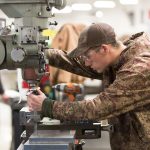- Study blueprints, sketches, or specifications
- Calculate dimensions to be welded
- Inspect structures or materials to be welded
- Ignite torches or start power supplies
- Monitor the welding process to avoid overheating
- Maintain equipment and machinery
Welding is the most common way of permanently joining metal parts. In this process, heat is applied to metal pieces, melting and fusing them to form a permanent bond. Because of its strength, welding is used in shipbuilding, automobile manufacturing and repair, aerospace applications, and thousands of other manufacturing activities. Welding also is used to join steel beams in the construction of buildings, bridges, and other structures and to join pipes in pipelines, power plants, and refineries.
Welders work in a wide variety of industries, from car racing to manufacturing. The work that welders do and the equipment they use vary with the industry. Arc welding, the most common type of welding today, uses electrical currents to create heat and bond metals together—but there are more than 100 different processes that a welder can use. The type of weld normally is determined by the types of metals being joined and the conditions under which the welding is to take place.


